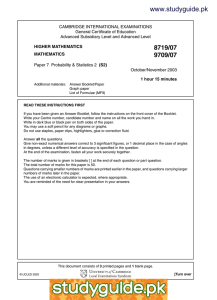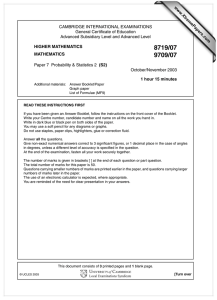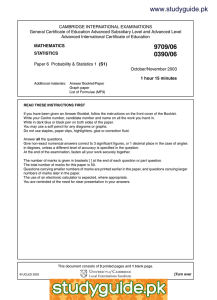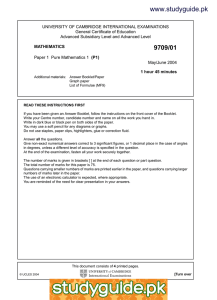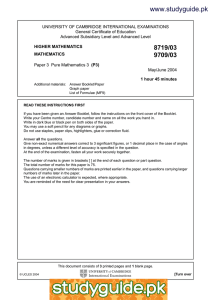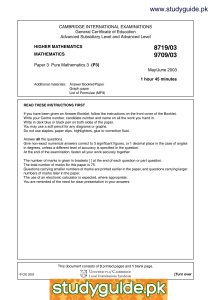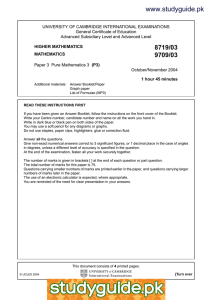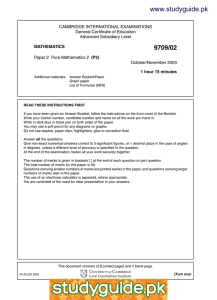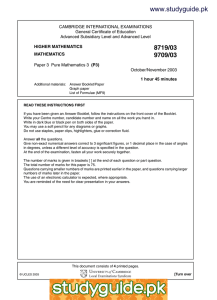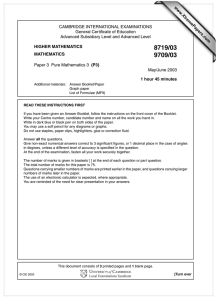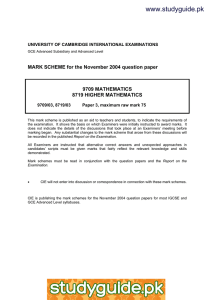www.studyguide.pk
advertisement
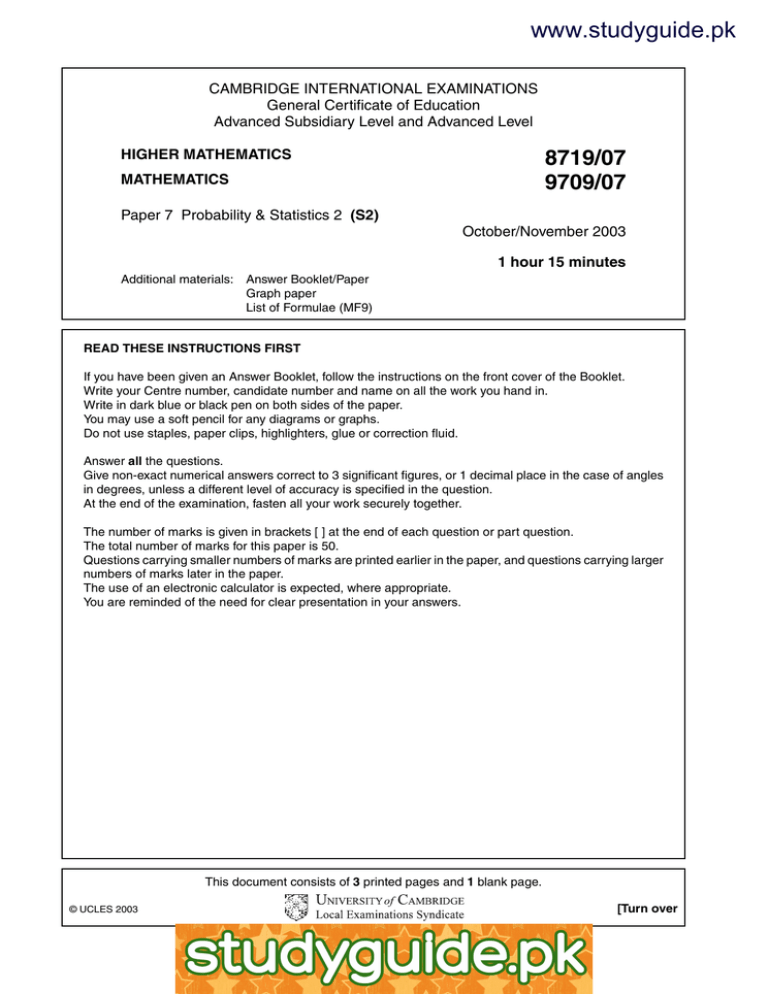
www.studyguide.pk CAMBRIDGE INTERNATIONAL EXAMINATIONS General Certificate of Education Advanced Subsidiary Level and Advanced Level HIGHER MATHEMATICS 8719/07 9709/07 MATHEMATICS Paper 7 Probability & Statistics 2 (S2) October/November 2003 1 hour 15 minutes Additional materials: Answer Booklet/Paper Graph paper List of Formulae (MF9) READ THESE INSTRUCTIONS FIRST If you have been given an Answer Booklet, follow the instructions on the front cover of the Booklet. Write your Centre number, candidate number and name on all the work you hand in. Write in dark blue or black pen on both sides of the paper. You may use a soft pencil for any diagrams or graphs. Do not use staples, paper clips, highlighters, glue or correction fluid. Answer all the questions. Give non-exact numerical answers correct to 3 significant figures, or 1 decimal place in the case of angles in degrees, unless a different level of accuracy is specified in the question. At the end of the examination, fasten all your work securely together. The number of marks is given in brackets [ ] at the end of each question or part question. The total number of marks for this paper is 50. Questions carrying smaller numbers of marks are printed earlier in the paper, and questions carrying larger numbers of marks later in the paper. The use of an electronic calculator is expected, where appropriate. You are reminded of the need for clear presentation in your answers. This document consists of 3 printed pages and 1 blank page. [Turn over © UCLES 2003 http://www.xtremepapers.net www.studyguide.pk 2 1 The result of a memory test is known to be normally distributed with mean µ and standard deviation 1.9. It is required to have a 95% confidence interval for µ with a total width of less than 2.0. Find the least possible number of tests needed to achieve this. [4] 2 A certain machine makes matches. One match in 10 000 on average is defective. Using a suitable approximation, calculate the probability that a random sample of 45 000 matches will include 2, 3 or 4 defective matches. [5] 3 Tien throws a ball. The distance it travels can be modelled by a normal distribution with mean 20 m and variance 9 m2 . His younger sister Su Chen also throws a ball and the distance her ball travels can be modelled by a normal distribution with mean 14 m and variance 12 m2 . Su Chen is allowed to add 5 metres on to her distance and call it her ‘upgraded distance’. Find the probability that Tien’s distance is larger than Su Chen’s upgraded distance. [5] 4 The number of emergency telephone calls to the electricity board office in a certain area in t minutes 1 is known to follow a Poisson distribution with mean 80 t. (i) Find the probability that there will be at least 3 emergency telephone calls to the office in any 20-minute period. [4] (ii) The probability that no emergency telephone call is made to the office in a period of k minutes [4] is 0.9. Find k. 5 The distance driven in a week by a long-distance lorry driver is a normally distributed random variable with mean 1850 km and standard deviation 117 km. (i) Find the probability that in a random sample of 26 weeks his average distance driven per week is more than 1800 km. [3] (ii) New driving regulations are introduced and in a random sample of 26 weeks after their introduction the lorry driver drives a total of 47 658 km. Assuming the standard deviation remains unchanged, test at the 10% level whether his mean weekly driving distance has changed. [5] 6 (i) Explain what is meant by (a) a Type I error, [1] (b) a Type II error. [1] (ii) Roger thinks that a box contains 6 screws and 94 nails. Felix thinks that the box contains 30 screws and 70 nails. In order to test these assumptions they decide to take 5 items at random from the box and inspect them, replacing each item after it has been inspected, and accept Roger’s hypothesis (the null hypothesis) if all 5 items are nails. (a) Calculate the probability of a Type I error. [4] (b) If Felix’s hypothesis (the alternative hypothesis) is true, calculate the probability of a Type II error. [3] 9709/07/O/N/03 www.studyguide.pk 3 7 The lifetime, x years, of the power light on a freezer, which is left on continuously, can be modelled by the continuous random variable with density function given by f(x) = ke−3x 0 x > 0, otherwise, where k is a constant. (i) Show that k = 3. [2] (ii) Find the lower quartile. [3] (iii) Find the mean lifetime. [6] 9709/07/O/N/03 www.studyguide.pk 4 BLANK PAGE 9709/07/O/N/03
